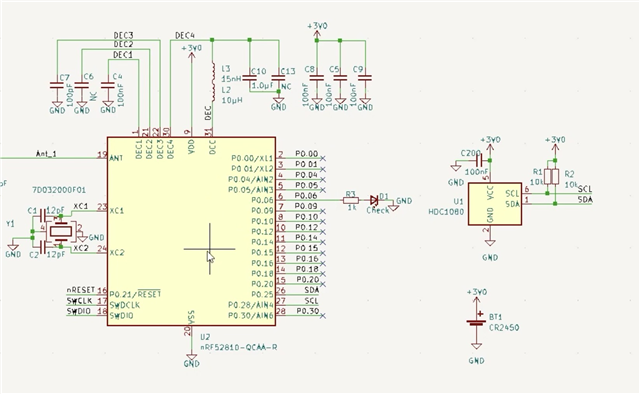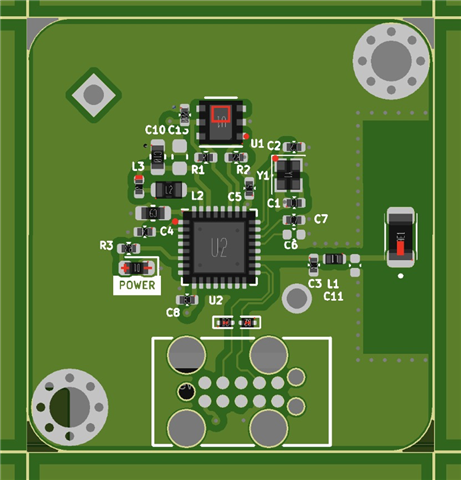I have a nRF52832 DK unit which I have developed against to get a HDC1080 reporting the temperature - everything works fine in the development setup.
I have recently had some devices manufactured using a nRF52810 and the device is giving an error 33281. I have read from previous posts that this is the slave nacking - which suggests that nothing can be found attached.
I stripped it back to basics and used the twi_scanner and it also reports no devices attached. I have tried with various `TWIS_DEFAULT_CONFIG_SCL_PULL`/`TWIS_DEFAULT_CONFIG_SDA_PULL`/`NRFX_TWIS_DEFAULT_CONFIG_SCL_PULL`/`NRFX_TWIS_DEFAULT_CONFIG_SDA_PULL` settings and nothing gets it working.
Relevant config:
- TWI_INSTANCE_ID 0
- TWI_ENABLED 1
- TWI0_ENABLED 1
- TWI0_USE_EASY_DMA 1
And the main file (which is basically the example mentioned above):
/**
* Copyright (c) 2016 - 2021, Nordic Semiconductor ASA
*
* All rights reserved.
*
* Redistribution and use in source and binary forms, with or without modification,
* are permitted provided that the following conditions are met:
*
* 1. Redistributions of source code must retain the above copyright notice, this
* list of conditions and the following disclaimer.
*
* 2. Redistributions in binary form, except as embedded into a Nordic
* Semiconductor ASA integrated circuit in a product or a software update for
* such product, must reproduce the above copyright notice, this list of
* conditions and the following disclaimer in the documentation and/or other
* materials provided with the distribution.
*
* 3. Neither the name of Nordic Semiconductor ASA nor the names of its
* contributors may be used to endorse or promote products derived from this
* software without specific prior written permission.
*
* 4. This software, with or without modification, must only be used with a
* Nordic Semiconductor ASA integrated circuit.
*
* 5. Any software provided in binary form under this license must not be reverse
* engineered, decompiled, modified and/or disassembled.
*
* THIS SOFTWARE IS PROVIDED BY NORDIC SEMICONDUCTOR ASA "AS IS" AND ANY EXPRESS
* OR IMPLIED WARRANTIES, INCLUDING, BUT NOT LIMITED TO, THE IMPLIED WARRANTIES
* OF MERCHANTABILITY, NONINFRINGEMENT, AND FITNESS FOR A PARTICULAR PURPOSE ARE
* DISCLAIMED. IN NO EVENT SHALL NORDIC SEMICONDUCTOR ASA OR CONTRIBUTORS BE
* LIABLE FOR ANY DIRECT, INDIRECT, INCIDENTAL, SPECIAL, EXEMPLARY, OR
* CONSEQUENTIAL DAMAGES (INCLUDING, BUT NOT LIMITED TO, PROCUREMENT OF SUBSTITUTE
* GOODS OR SERVICES; LOSS OF USE, DATA, OR PROFITS; OR BUSINESS INTERRUPTION)
* HOWEVER CAUSED AND ON ANY THEORY OF LIABILITY, WHETHER IN CONTRACT, STRICT
* LIABILITY, OR TORT (INCLUDING NEGLIGENCE OR OTHERWISE) ARISING IN ANY WAY OUT
* OF THE USE OF THIS SOFTWARE, EVEN IF ADVISED OF THE POSSIBILITY OF SUCH DAMAGE.
*
*/
/** @file
* @defgroup tw_scanner main.c
* @{
* @ingroup nrf_twi_example
* @brief TWI Sensor Example main file.
*
* This file contains the source code for a sample application using TWI.
*
*/
#include <stdio.h>
#include "boards.h"
#include "app_util_platform.h"
#include "app_error.h"
#include "nrf_drv_twi.h"
#include "nrf_log.h"
#include "nrf_log_ctrl.h"
#include "nrf_log_default_backends.h"
/* TWI instance ID. */
#if TWI0_ENABLED
#define TWI_INSTANCE_ID 0
#elif TWI1_ENABLED
#define TWI_INSTANCE_ID 1
#endif
/* Number of possible TWI addresses. */
#define TWI_ADDRESSES 127
/* TWI instance. */
static const nrf_drv_twi_t m_twi = NRF_DRV_TWI_INSTANCE(TWI_INSTANCE_ID);
/**
* @brief TWI initialization.
*/
void twi_init (void)
{
ret_code_t err_code;
const nrf_drv_twi_config_t twi_config = {
.scl = 27,
.sda = 26,
.frequency = NRF_DRV_TWI_FREQ_100K,
.interrupt_priority = APP_IRQ_PRIORITY_HIGH,
.clear_bus_init = false
};
err_code = nrf_drv_twi_init(&m_twi, &twi_config, NULL, NULL);
APP_ERROR_CHECK(err_code);
nrf_drv_twi_enable(&m_twi);
}
/**
* @brief Function for main application entry.
*/
int main(void)
{
ret_code_t err_code;
uint8_t address;
uint8_t sample_data;
bool detected_device = false;
APP_ERROR_CHECK(NRF_LOG_INIT(NULL));
NRF_LOG_DEFAULT_BACKENDS_INIT();
NRF_LOG_INFO("TWI scanner started.");
NRF_LOG_FLUSH();
twi_init();
for (address = 1; address <= TWI_ADDRESSES; address++)
{
err_code = nrf_drv_twi_rx(&m_twi, address, &sample_data, sizeof(sample_data));
if (err_code == NRF_SUCCESS)
{
detected_device = true;
NRF_LOG_INFO("TWI device detected at address 0x%x.", address);
} else
{
NRF_LOG_INFO("error %d", err_code);
}
NRF_LOG_FLUSH();
}
if (!detected_device)
{
NRF_LOG_INFO("No device was found.");
NRF_LOG_FLUSH();
}
while (true)
{
/* Empty loop. */
}
}
/** @} */
I have attached an image of the schematics, in case there's anything wrong there.


Is there anything else I may be missing between the dev kit and a prototype configuration wise?
Details:
Using latest SES and latest available Nordic SDK (nRF5_SDK_17.1.0_ddde560).


